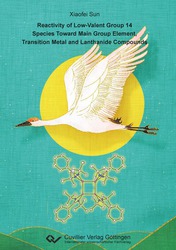| Departments | |
|---|---|
| Book Series (96) |
1378
|
| Nachhaltigkeit |
3
|
| Gesundheitswesen |
1
|
| Humanities |
2365
|
| Natural Sciences |
5406
|
| Mathematics | 229 |
| Informatics | 319 |
| Physics | 980 |
| Chemistry | 1363 |
| Geosciences | 131 |
| Human medicine | 243 |
| Stomatology | 10 |
| Veterinary medicine | 108 |
| Pharmacy | 147 |
| Biology | 835 |
| Biochemistry, molecular biology, gene technology | 121 |
| Biophysics | 25 |
| Domestic and nutritional science | 45 |
| Agricultural science | 1004 |
| Forest science | 201 |
| Horticultural science | 20 |
| Environmental research, ecology and landscape conservation | 148 |
| Engineering |
1793
|
| Common |
98
|
|
Leitlinien Unfallchirurgie
5. Auflage bestellen |
|
Advanced Search
Reactivity of Low-Valent Group 14 Species Toward Main Group Element, Transition Metal and Lanthanide Compounds (English shop)
Xiaofei Sun (Author)Preview
Extract, PDF (490 KB)
Table of Contents, PDF (170 KB)
Die Dissertation befasst sich mit der Anwendung von niedervalenten Gruppe-14-Verbindungen in metallorganischer Chemie und Hauptgruppenchemie. Ausgehend von mono- und divalenten Siliziumverbindungen wurde die analoge Siliziumverbindung des 2π-Hückel-aromatischen Verbindung dargestellt (Kapitel 3.1). Ein chirales Silen wurde synthetisiert und weitere Reaktivität mit unterschiedlichen kleinen Molekülen untersucht (Kapitel 3.2). Außerdem wurden bidentate Silylene als Liganden zur Stabilisierung von Seldenerdelementen, Erdalkalielementen und Gruppe-12-Metallen eingesetzt (Kapitel 3.3-3.4). Verschiedene Polyphosphide wurden aus reduzierenden Silylenen oder Plumbolen generiert (Kapitel 3.5-3.6). Die dianionischen Gruppe-14-Metallole, Silol, Germol und Plumbol wurden als Liganden für sandwichartige Lanthanidkomplexe eingesetzt und die magnetischen Eigenschaften der Er-Verbindung wurden untersucht (Kapitel 3.7-3.8).
The dissertation focuses on the application of low-valent group 14 species in organometallic and main group chemistry. Using mono- and divalent silicon compounds, the silicon analogue of a 2π Hückel aromatic compound was isolated (chapter 3.1). A chiral silene was synthesized and the reactivity was studied toward different small molecules (chapter 3.2). Moreover, bidentate silylenes were used as ligands to stabilize rare-earth elements, alkaline-earth elements as well as group 12 metals (chapter 3.3-3.4). Polyphosphides were achieved by using silylenes or plumboles as reducing agents (chapter 3.5-3.6). Dianionic group 14 metalloles, namely, silole, germole and plumboles were used as ligands for sandwich-type lanthanide complexes and the magnetic properties of the Er compound was studied (chapter 3.7-3.8).
| ISBN-13 (Hard Copy) | 9783736976627 |
| ISBN-13 (eBook) | 9783736966628 |
| Final Book Format | A5 |
| Language | English |
| Page Number | 258 |
| Lamination of Cover | matt |
| Edition | 1. |
| Publication Place | Göttingen |
| Place of Dissertation | Karlsruhe |
| Publication Date | 2022-08-22 |
| General Categorization | Dissertation |
| Departments |
Inorganic chemistry
|
| Keywords | Hauptgruppenelemente, Silizium, Gruppe 14, Übergangsmetalle, Lanthanide, Seltenerdelemente, Niedervalente Verbindungen, Reaktivität, Synthese, Aromatizität, Tetrasilacyclobutadien-Dikation, Mechanismus, Chiralität, Silylen, Erdalkalimetalle, Zink, Cadmium, Phosphor, Calcium, Strontium, Barium, Yttrium, Lanthan, Cer, Samarium, Europium, Ytterbium, Silen, Polyphosphide, Metallole, Silole, Germole, Plumbole, Heterocyclen, Sandwichverbindungen, Koordinationschemie, Magnetismus, Tieftemperaturmatrix, Lewis-Base, Lewis-Säure, mesomere Stabilisierung, heterozyklische Silylene, schwere Cp-Metallole, Diastereoselektivität, terminale Olefine, Liganden Main-group elements, silicon, group 14, transition metals, lanthanides, rare-earth elements, low-valent compounds, reactivity, synthesis, aromaticity, tetrasilacyclobutadiene dication, mechanism, chirality, silylene, alkaline earth metals, zinc, cadmium, phosphorus, calcium, strontium, barium, yttrium, lanthanum, cerium, samarium, europium, ytterbium, silene, polyphosphides, metallole, silole, germole, plumbole, heterocycle, sandwich compound, coordination chemistry, low-temperature matrix, Lewis acid, mesomeric stabilization, heterocyclic silylenes, heavy Cp metalloles, terminal olefins, diastereoselectivity, ligands |








